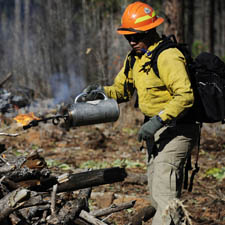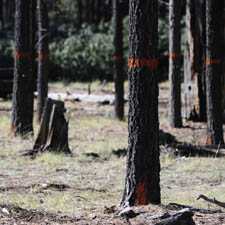Cronkite News has moved to a new home at cronkitenews.azpbs.org. Use this site to search archives from 2011 to May 2015. You can search the new site for current stories.
Experts: Managing tribal forest helped stop Wallow Fire at reservation
WHITERIVER – Blackened, rusted and bent, a barbed wire fence snakes along the boundary of the Fort Apache Indian Reservation and the Apache-Sitgreaves National Forests in eastern Arizona’s White Mountains.
To the east, a sea of black rolls with the land as trees resemble burnt matchsticks. The national forest stand is dense with young trees. Most won’t survive.
To the west, on tribal land, the trees are spread farther apart, with blackened dirt hidden by growth of wild strawberries and forest grasses. The trees on this side of the fence, for the most part, will live.
It was along this line that fire ecologists and forest managers say the westward expansion of the Wallow Fire, the largest in Arizona’s history, slowed and eventually stopped.
Touring the area, Jonathan Brooks, tribal forest manager for the White Mountain Apache Tribe, said forest-management strategies unhindered by environmental litigation and drawn-out federal government processes helped check the wildfire here.
For decades, the tribe has cleared young trees, logged larger trees and burned underbrush to replicate the natural burn-and-growth cycle of the Ponderosa pine forest. Brooks said that made it easy for firefighters to create a backfire here to deprive the approaching Wallow Fire of fuel.
“Had this area not been thinned, logged, prescribe-burned, we wouldn’t have been able to do a burnout operation here – so the fire would’ve been able to come through here unchecked,” he said.
A new federal government report that analyzed the Wallow Fire’s impact on tribal lands supports Brooks’ assessment. In addition, the Wallow Fire Fuels Treatment Effectiveness Report, prepared by agencies including the U.S. Fish and Wildlife Service and Bureau of Indian Affairs, notes that the Wallow Fire killed fewer trees on the Fort Apache and San Carlos Apache reservations because it burned less intensely there.
The Apache-Sitgreaves National Forests took the brunt of the Wallow Fire, which burned a total of 538,049 acres across two states, consuming 32 homes and four commercial properties and leaving 36 outbuildings in ashes, according to the Incident Information System, an inter-agency website.
Wally Covington, director of Northern Arizona University’s Ecological Restoration Institute, said tribes can conduct forest treatments faster and cheaper because the stakeholders are limited to tribal members.
For national forests, he said, decisions are subject to extensive federal processes in which more people are involved and environmental assessments are more costly. There are lessons to be learned from neighboring tribal lands on how to better manage national forests, such as increasing cost-effectiveness by assessing larger tracts of land for treatment, Covington said.
“How can we do this faster and more efficiently?” he said. “Tribal forestry throughout the West has done some very innovative techniques.”
Managing a forest
At times, Jere Classay is hidden from view as plumes of smoke rise from wood piles stacked along a forest access road on the Fort Apache Indian Reservation.
He is a lead forestry technician with firefighters conducting season-ending fire treatments near McNary to clear mounds of logs left from a forest-thinning treatment around the tribal community.
They are with the Bureau of Indian Affairs, the federal agency that develops and runs the reservation’s fire-management plan in cooperation with tribal forestry officials.
The treatment is just one example of forest-management practices that balance logging by private companies, prescribed burning and a policy of removing dense stands of trees throughout the reservation. The effect: large-scale forest thinning across tribal lands.
“When you work on treated land with logging or thinning or prescribed fire – whatever you use to treat that land, then it’s a lot easier to control the wildfire,” Classay said. “We maintain our forests so if (wildfire) does come onto our reservation then we have a better chance of controlling and containing it compared to their side.”
More than 500,000 of the 1.6 million acres of forest within Fort Apache is dedicated to managing trees for sale.
This process, according to Orlando Carroll, a Fort Apache timber sales forester with the Bureau of Indian Affairs, is a combination of forest treatments that start with preparing an area for logging by private companies. This includes selecting trees that will not only provide viable logs but also selecting them in such a way that shapes the forest to a desired state.
As private logging companies harvest the selected trees, they thin the forest. After that, crews conduct additional thinning such as removing small trees in dense stands to allow intentional fires to be set in the area roughly one year later, mimicking historic slow-moving fires that burn through Ponderosa pine forests, Carroll said.
A major part of the tribe’s strategy is prescribed fires. Since the early 1950s, the tribe has conducted large-scale burns in coordination with the Bureau of Indian Affairs on tens of thousands of acres each year.
Robert Lacapa, Fort Apache’s forest manager for the Bureau of Indian Affairs, said the agency and tribe need to treat up to 70,000 acres per year to maintain the nearly 2 million acres of forest.
With a strategy that manages trees on thousands of acres annually by using forest-thinning, timber-harvesting and prescribed-burning, the tribe’s approach has created healthy forest conditions that are easier to manage during wildfires, Lacapa said.
“The forests for the White Mountain Apache Tribe, they’re very important for livelihood, for economics, cultural aspects, recreation,” Brooks said. “There’s so many benefits that the land and that the forests provide for the tribe, and it’s very important for us to actively manage it to keep the forest healthy so that everything kind of maintains its balance.”
But managing the forest extends beyond its benefits to the tribe. Leon Ben Jr., regional fire management officer for the Bureau of Indian Affairs, said this process also protects against devastating wildfires.
From a regional perspective, Ben said the goal of the treatments is “taking away the possibility, or minimizing the possibility, of catastrophic wildland fires to protect our communities. And also at the same time managing our fuels, managing our forests, for future generations.”
The report
The Wallow Fire did encroach into Fort Apache’s tribal land, burning about 13,000 acres along the eastern boundary despite a prevailing wind from the west. It also reached the neighboring San Carlos Apache Tribe lands, burning another 9,162 acres.
But according to Brooks, more than 90 percent of the fire that burned through the Fort Apache Indian Reservation was part of a backfire operation to protect lands farther west, including Mount Baldy, Arizona’s second-highest mountain, and Sunrise Park Resort.
The Wallow Fire Fuels Treatment Effectiveness Report concludes that decades of aggressive forest management contributed directly to a decrease in burn intensity on tribal lands, stopping the westward growth of the Wallow Fire.
The report, expected to be released in late 2011 or early 2012 on agency websites, was conducted by a team of federal agencies and fire ecology experts from the Bureau of Indian Affairs, National Interagency Fire Center and U.S. Fish and Wildlife Service and included findings from the 2011 Wallow Fire Burned Area Emergency Stabilization Plan.
The approaching wildfire was a crown fire, in which flames reach the tops of trees and spread rapidly at intense temperatures. But when it reached tribal lands, the report said, it dropped to the ground, enabling fire crews to secure the edge of the fire by setting backfires.
The strategies “resulted in a limited number of acres classified as high and moderate soil burn severity,” where trees die and soil is degraded by high temperatures, the report said. This tree death rate reached only 10 percent on tribal lands, including forests on the neighboring San Carlos Apache Reservation.
In the Apache-Sitgreaves National Forests, intense burning affected 58 percent of the forest, where fire temperatures resulted in tree death rates greater than 50 percent, according to a September U.S. Forest Service report detailing forest vegetation after the Wallow Fire.
The fuels treatment report takes this assessment further, concluding that fuel treatments on the Fort Apache Indian Reservation allowed forest managers to safely set backfires, keeping the impact to tribal land to a minimum and “significantly reduced costs for suppression and post-fire rehabilitation.”
The report credited the many treatments conducted on the reservation through the years with stopping the Wallow Fire’s spread.
“It’s not about one fire; it’s about a mosaic of fires on a landscape that provided that positive result,” said Mary Taber, a Bureau of Indian Affairs fire ecologist at the National Interagency Fire Center who helped compile data for the report. “The core themes of the report [are] that this mosaic of fire treatments over decades led to the successful result of being able to stop the fire there in a safe manner.”
Apache-Sitgreaves
Under the 2004 White Mountain Stewardship Contract, awarded by the U.S. Forest Service to treat up to 15,000 acres per year over 10 years, a private firm has thinned the forest around communities to reduce the fire danger.
Those treatments worked around communities like Alpine, Nutrioso, Springerville and Greer, according to Jim Zornes, deputy forest supervisor with Apache-Sitgreaves National Forests.
“We still had losses in areas that had been treated, but those losses weren’t nearly as great and it’s more of an individual or small group loss of trees,” Zornes said. “Those treatments do make a difference.”
With more than 500,000 acres burned by the Wallow Fire on land adjacent to the Fort Apache Indian Reservation, Zornes and several Forest Service personnel interviewed by Cronkite News Service said the Apache-Sitgreaves National Forests needs to start treating more acres to prevent catastrophic wildfires.
“One of the lessons learned is that forest restoration treatments are effective … the second lesson is that we haven’t done enough acres – we just need to do more,” said James Youtz, a regional forest health and growth expert with the U.S. Forest Service who said he only spoke from his experience and not the official perspective of the Forest Service.
Youtz, a former Bureau of Indian Affairs employee, said he doesn’t think examining the Wallow Fire is a good way to compare national forest and tribal land-management strategies because the wildfire moved mostly north and east along the reservation’s flank. But he did say that differences between forests on each side of the boundary were apparent.
“We have closed canopies with even aged stands that basically burn with crown fire behavior,” Youtz said. “The tribe is able to implement a lot of treatments at a faster pace than we’ve been able to.”
The Apache-Sitgreaves National Forests historically had tree densities between 20 and 60 trees per acre; now it averages more than 400 trees per acre, according to 2010 information from the National Database of State and Local Wildfire Hazard Mitigation Programs at the U.S. Department of Agriculture.
The highest rate of tree death from intense burning at high temperatures during the Wallow Fire occurred in dense tree stands, according to Covington, the NAU forest ecology expert.
He said the current situation in the Apache-Sitgreaves and other western forests results from decades of aggressively suppressing wildfires, fueling overcrowding, disease and dry conditions that result in catastrophic crown fires.
“These are very large landscape-management problems,” Covington said. “We’re kind of sitting ducks, in a way, in a fuel matrix.”
A larger scale
Jim Pitts, a forest health and growth expert with Apache-Sitgreaves National Forests, said there is general agreement that forests need to be managed at a larger scale. As for how to do that, he said forest managers and the public should look to what is happening on tribal lands.
“Some of our publics are going to have to look at what the tribe operations are and see how they do things,” Pitts said. “We’ve got to work closer along the boundary. What they do on their side we need to try to do on our side, and the timing of those projects needs to coincide so we get the maximum benefit out of that.”
Youtz, with the regional office of the Forest Service, said conducting treatments like logging and increased prescribed burning has to go through a lengthy process of environmental assessments and public input on national forests. He said this process is faster on tribal lands because the people involved with the assessment are limited to the tribal council and Bureau of Indian Affairs.
“The stakeholders that comment on, object to and appeal to projects are different than they are on the national forests,” Youtz said.
Robert Lacapa, Bureau of Indian Affairs forest manager for Fort Apache, said the public has driven the current state of forest lands in the West, adding that this also has contributed to a decline in logging industry infrastructure like sawmills in national forests.
“The industry was really driven by the product and the product was really driven by the management and the management was really driven by the people,” Lacapa said. “It starts with what the public wants to see. I think the public sort of drove the state of the Forest Service at this point.”
He said the Forest Service has challenges on multiple fronts, one of which is a lack of private logging firms able to thin and sell logs. This, according to Lacapa and others in tribal and national forest land-management, can be attributed to environmental litigation from the ’90s, which prevented certain types of logging and thinning in national forests.
Lacapa said the tribe is able to do more thinning because there is a sawmill on the Fort Apache reservation, allowing wood harvested from the forest to be taken there and sold. The tribe gets a portion of the revenue.
But the tribe’s mill has now been closed for three years, slowing logging on reservation land. Lacapa said one part of the problem is a slow timber industry nationwide and the other poor management of the mill. He said the bureau is working with the mill and hopes to make progress on reopening the facility within the next several months.
In addition to the mill, Lacapa said his constituency is easier to work with because it is much smaller and lives within a relatively small area.
“You are managing for the whole nation, but it just so happens that there are 15,000 people in that nation here,” he said.
The future
A new plan called the Four Forest Restoration Initiative, which seeks to treat up to 2.4 million acres of land on the Apache-Sitgreaves, Coconino, Kaibab and Tonto national forests, is being discussed by forest-management officials, environmental organizations, the public and private industry. Its scope even exceeds the amount of thinning being done on the Apache reservations.
A portion of this plan was proposed this summer and sets out to mechanically thin nearly 400,000 acres, with prescribed-burning planned for another 600,000. The plan includes private industry such as wood pellet mills that can use the small trees cleared from the forest. An environmental impact statement was expected by early 2012.
Zornes, the deputy forest supervisor for the Apache-Sitgreaves National Forests, said the initiative is a good approach for the next step in forest-management.
“The future is very promising,” Zornes said. “Any time we can take and find a use for this material instead of putting it up in smoke – whether prescribed fire, wildfire or pellet burning – even if we can break even is good.”
Environmental groups like The Nature Conservancy, Grand Canyon Trust and the Tucson-based Center for Biological Diversity have said they support the initiative.
“[The Four Forest Restoration Initiative] is by far the largest and fastest-moving forest-restoration project ever attempted,” said Marcus Selig, Arizona forest conservation program associate for the Grand Canyon Trust. “We need to do something, and industry needs to be involved to be cost-effective.”
In the early ’90s, the logging industry was at odds with environmental groups over how to manage national forests. One of the groups that litigated to curb logging of old-growth trees, in part to protect the Mexican spotted owl, was the Center for Biological Diversity.
Now, according to Taylor McKinnon, the center’s public lands campaign manager, strategic thinning of small trees is something the center would like to see if it preserves older trees.
“The big question is: Is the Forest Service going to come along with these strategies?” McKinnon said. “And that’s uncertain.”
NAU’s Covington said time is running out.
“We’ve got to get it done within the next couple of decades,” he said. “If we’ve lost a million acres in the last decade, we could lose a lot more soon.”












